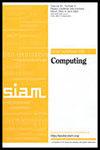近似戈莫里-胡树比[数学]最大流量更快
IF 1.6
3区 计算机科学
Q3 COMPUTER SCIENCE, THEORY & METHODS
引用次数: 0
摘要
SIAM 计算期刊》,第 53 卷第 4 期,第 1162-1180 页,2024 年 8 月。 摘要。Gomory-Hu 树或切割树 [R. E. Gomory and T. C. Hu, J. Soc.E. Gomory and T. C. Hu, J. Soc. Indust.应用数学》,9 (1961),第 551-570 页]是一种经典的数据结构,用于报告无向图中所有成对顶点[math]和[math]的[math]-mincuts(以及对偶性,[math]-maxflows 的值)。Gomory 和 Hu 证明,可以用 [math] 精确最大流计算来计算它。令人惊讶的是,50 多年后的今天,这仍然是 Gomory-Hu 树的最佳算法,甚至对于近似最小切分也是如此。在本文中,我们打破了这一长期存在的障碍,给出了一种使用[math] maxflow 计算来计算[math]近似 Gomory-Hu 树的算法。具体来说,我们获得了下面描述的运行时间边界。我们获得了一种针对无向加权图的随机(蒙特卡洛)算法,它能在[math]时间内运行,并以高概率(w.h.p.)返回一棵[math]近似的 Gomory-Hu 树。在此之前,已知的最佳运行时间是[math],它是通过在图的剪切疏解器上运行 Gomory 和 Hu 的原始算法得到的。接下来,我们得到了一种针对无向、无权重图的随机(蒙特卡罗)算法,该算法的运行时间为[math],并能返回一个[math]近似的 Gomory-Hu 树w.h.p。在此之前,已知无权重图的最佳运行时间是精确 Gomory-Hu 树的 [math] [A. Bhalgat et al.Bhalgat et al., Proceedings of the 39th Annual ACM Symposium on Theory of Computing, San Diego, CA, 2007, pp.由于我们的 Gomory-Hu 树算法,我们还能在相同的时间界限内解决[math]近似全对最小裁剪(APMC)和单源最小裁剪(SSMC)问题。(这些问题比较简单,因为我们的目标只是返回[math]-mincut 值,而不是 mincut)。这改进了 Abboud、Krauthgamer 和 Trabelsi 最近提出的在[math]时间内解决这些问题的算法[2020 IEEE 第 61 届计算机科学基础年度研讨会,IEEE 计算机学会,2020 年,第 105-118 页]。本文章由计算机程序翻译,如有差异,请以英文原文为准。
Approximate Gomory–Hu Tree is Faster than [math] Maximum Flows
SIAM Journal on Computing, Volume 53, Issue 4, Page 1162-1180, August 2024.
Abstract. The Gomory–Hu tree or cut tree [R. E. Gomory and T. C. Hu, J. Soc. Indust. Appl. Math., 9 (1961), pp. 551–570] is a classic data structure for reporting [math]-mincuts (and by duality, the values of [math]-maxflows) for all-pairs of vertices [math] and [math] in an undirected graph. Gomory and Hu showed that it can be computed using [math] exact maxflow computations. Surprisingly, this remains the best algorithm for Gomory–Hu trees more than 50 years later, even for approximate mincuts. In this paper, we break this longstanding barrier and give an algorithm for computing a [math]-approximate Gomory–Hu tree using [math] maxflow computations. Specifically, we obtain the running time bounds we describe below. We obtain a randomized (Monte Carlo) algorithm for undirected, weighted graphs that runs in [math] time and returns a [math]-approximate Gomory–Hu tree with high probability (w.h.p.). Previously, the best running time known was [math], which is obtained by running Gomory and Hu’s original algorithm on a cut sparsifier of the graph. Next, we obtain a randomized (Monte Carlo) algorithm for undirected, unweighted graphs that runs in [math] time and returns a [math]-approximate Gomory–Hu tree w.h.p. This improves on our first result for sparse graphs, namely [math]. Previously, the best running time known for unweighted graphs was [math] for an exact Gomory–Hu tree [A. Bhalgat et al., Proceedings of the 39th Annual ACM Symposium on Theory of Computing, San Diego, CA, 2007, pp. 605–614]; no better result is known if approximations are allowed. As a consequence of our Gomory–Hu tree algorithms, we also solve the [math]-approximate all-pairs mincut (APMC) and single-source mincut (SSMC) problems in the same time bounds. (These problems are simpler in that the goal is to only return the [math]-mincut values, and not the mincuts.) This improves on the recent algorithm for these problems in [math] time due to Abboud, Krauthgamer, and Trabelsi [2020 IEEE 61st Annual Symposium on Foundations of Computer Science, IEEE Computer Society, 2020, pp. 105–118].
Abstract. The Gomory–Hu tree or cut tree [R. E. Gomory and T. C. Hu, J. Soc. Indust. Appl. Math., 9 (1961), pp. 551–570] is a classic data structure for reporting [math]-mincuts (and by duality, the values of [math]-maxflows) for all-pairs of vertices [math] and [math] in an undirected graph. Gomory and Hu showed that it can be computed using [math] exact maxflow computations. Surprisingly, this remains the best algorithm for Gomory–Hu trees more than 50 years later, even for approximate mincuts. In this paper, we break this longstanding barrier and give an algorithm for computing a [math]-approximate Gomory–Hu tree using [math] maxflow computations. Specifically, we obtain the running time bounds we describe below. We obtain a randomized (Monte Carlo) algorithm for undirected, weighted graphs that runs in [math] time and returns a [math]-approximate Gomory–Hu tree with high probability (w.h.p.). Previously, the best running time known was [math], which is obtained by running Gomory and Hu’s original algorithm on a cut sparsifier of the graph. Next, we obtain a randomized (Monte Carlo) algorithm for undirected, unweighted graphs that runs in [math] time and returns a [math]-approximate Gomory–Hu tree w.h.p. This improves on our first result for sparse graphs, namely [math]. Previously, the best running time known for unweighted graphs was [math] for an exact Gomory–Hu tree [A. Bhalgat et al., Proceedings of the 39th Annual ACM Symposium on Theory of Computing, San Diego, CA, 2007, pp. 605–614]; no better result is known if approximations are allowed. As a consequence of our Gomory–Hu tree algorithms, we also solve the [math]-approximate all-pairs mincut (APMC) and single-source mincut (SSMC) problems in the same time bounds. (These problems are simpler in that the goal is to only return the [math]-mincut values, and not the mincuts.) This improves on the recent algorithm for these problems in [math] time due to Abboud, Krauthgamer, and Trabelsi [2020 IEEE 61st Annual Symposium on Foundations of Computer Science, IEEE Computer Society, 2020, pp. 105–118].
求助全文
通过发布文献求助,成功后即可免费获取论文全文。
去求助
来源期刊

SIAM Journal on Computing
工程技术-计算机:理论方法
CiteScore
4.60
自引率
0.00%
发文量
68
审稿时长
6-12 weeks
期刊介绍:
The SIAM Journal on Computing aims to provide coverage of the most significant work going on in the mathematical and formal aspects of computer science and nonnumerical computing. Submissions must be clearly written and make a significant technical contribution. Topics include but are not limited to analysis and design of algorithms, algorithmic game theory, data structures, computational complexity, computational algebra, computational aspects of combinatorics and graph theory, computational biology, computational geometry, computational robotics, the mathematical aspects of programming languages, artificial intelligence, computational learning, databases, information retrieval, cryptography, networks, distributed computing, parallel algorithms, and computer architecture.
 求助内容:
求助内容: 应助结果提醒方式:
应助结果提醒方式:


